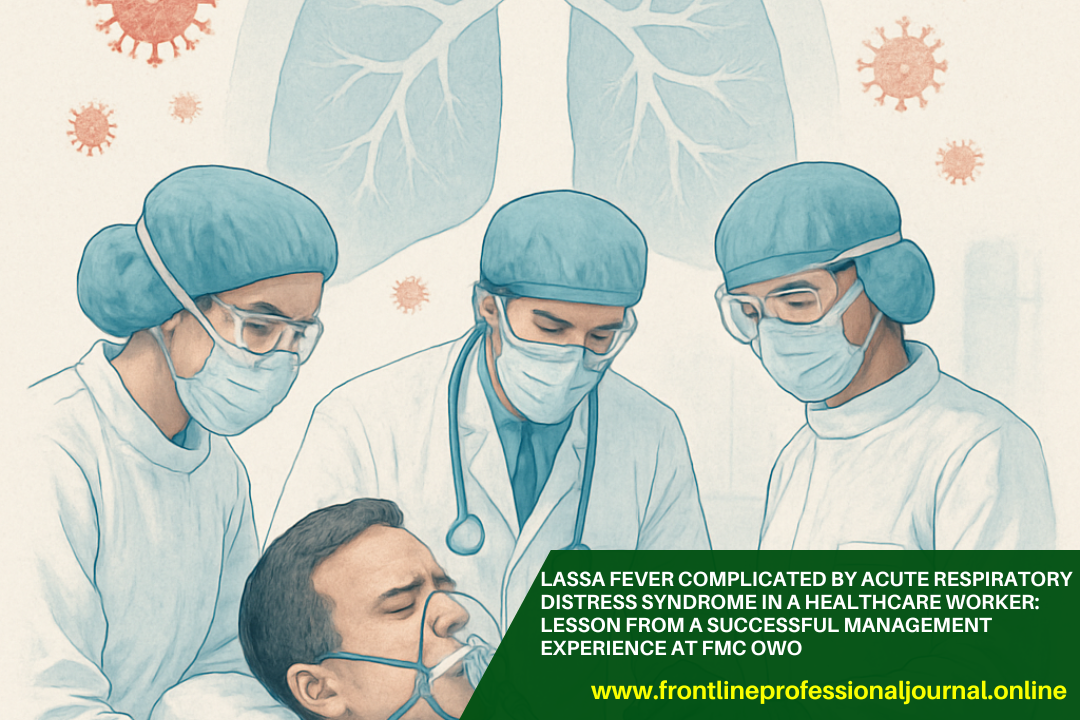
Authors: Isaac Ihinmikaye, Olufemi Oladele Ayodeji, Esther Jackson Fioboah, Olayinka Olubukola Komolafe, Adetumi Adetunji Subulade, Olalekan Ojo, and Liasu Adeagbo Ahmed
CITATION: Isaac Ihinmikaye, Olufemi Oladele Ayodeji, Esther Jackson Fioboah, Adetumi, Olayinka Olubukola Komolafe, Adetunji Subulade, Olalekan Ojo, and Liasu Adeagbo Ahmed (2025). Lassa fever complicated by acute respiratory distress syndrome in a healthcare worker: Lesson from a successful management experience at FMC Owo. Frontline Professionals Journal 2(11), 215-221
ABSTRACT
Lassa fever, a viral hemorrhagic disease endemic to West Africa, remains a major public health concern, particularly when complicated by acute respiratory distress syndrome (ARDS). Pulmonary involvement is relatively uncommon, occurring in approximately 3–20% of hospitalized cases, yet it is associated with mortality rates as high as 70%. The pathologic features of Lassa fever–associated ARDS include interstitial pneumonitis, pulmonary hemorrhage, and diffuse alveolar damage. Despite advances in supportive care, survival from this severe complication remains rare, especially among healthcare workers. We present a case report of a 29-year-old female healthcare worker diagnosed with Lassa fever complicated by ARDS. The patient was managed at the Federal Medical Centre (FMC) Owo Isolation Centre, Ondo State, Nigeria. Clinical data were retrieved from inpatient records, and management included standard antiviral therapy with intravenous ribavirin alongside comprehensive critical care support, mechanical ventilation, and multidisciplinary coordination. This case represents a rare survival outcome in Lassa fever complicated by ARDS. The patient’s illness progressed from mild febrile symptoms to severe respiratory failure requiring invasive mechanical ventilation. Her recovery was attributed to three key factors: early initiation of ribavirin therapy, aggressive and sustained critical care interventions, and prompt identification and management of secondary complications, including steroid-induced hyperglycemia, bacterial pneumonia, and electrolyte imbalance. Despite several episodes of clinical deterioration—including a transient cardiac arrest—the patient achieved full recovery following 26 days of hospitalization. Serial RT-PCR testing demonstrated progressive viral clearance, and she was discharged home in stable condition with appropriate follow-up care. This case highlights that survival from Lassa fever–associated ARDS, is achievable with timely diagnosis, early ribavirin administration, and advanced multidisciplinary care. It also underscores the occupational risks faced by healthcare workers and reinforces the need for strict infection prevention and improved intensive care capacity in resource-limited settings.








